Digital tracking technologies seem to offer access ‘into the candy-storeoftheir- dreams’ for urban designers and place managers. This report questions this premise and methodically measures the potential contribution that Wi-Fi monitoring and opt in survey data of people in urban precincts can contribute to more traditional public life surveys.

Why Wi-Fi?
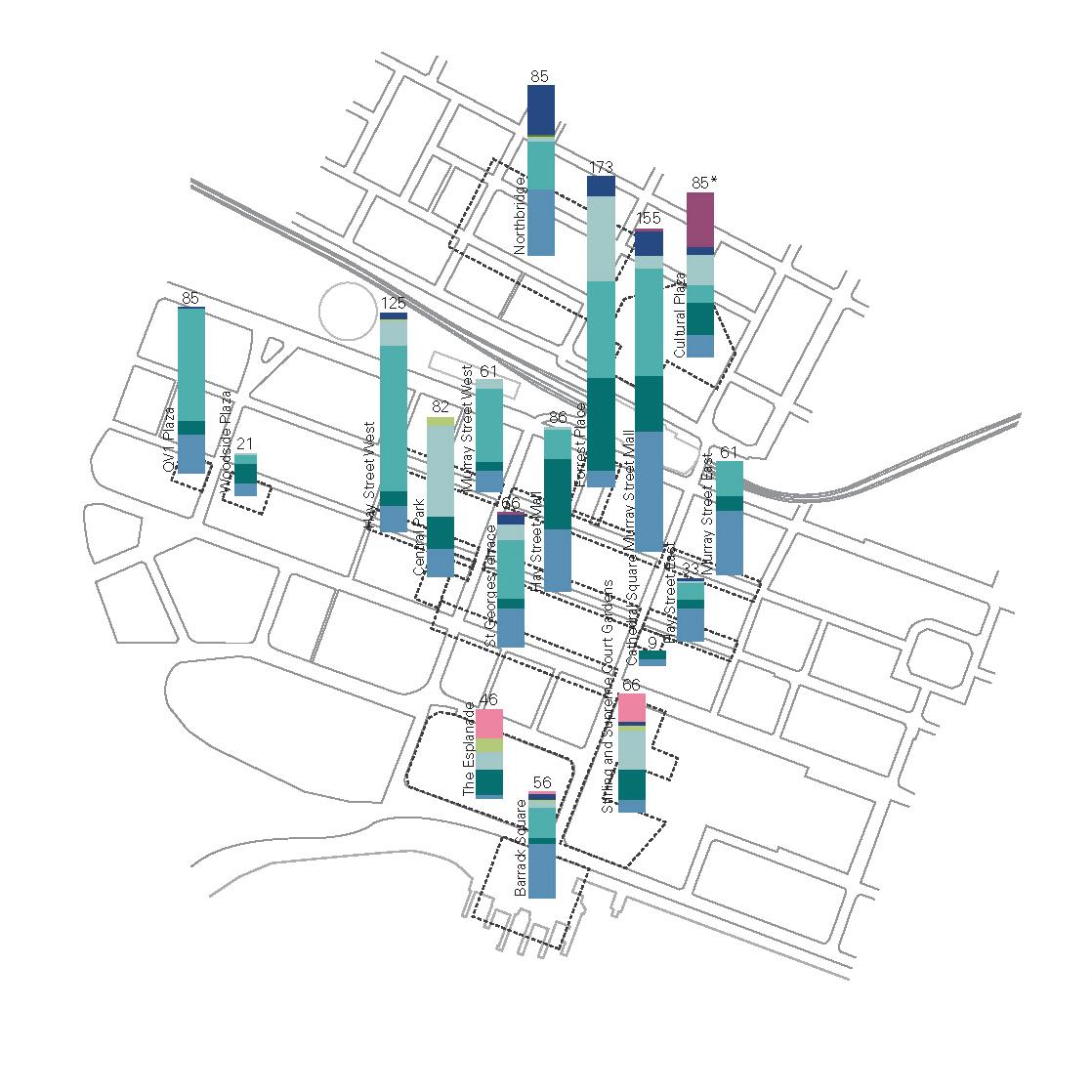
© Australian Urban Design Research Centre 2016 Evaluating Wi-Fi monitoring data for use in public life surveys
Executive summary
This report concerns the potential contribution that Wi-Fi monitoring can contribute to more conventional public life surveys
4
This report concerns the potential contribution that passive and active Wi-Fi monitoring and opt in survey data of people in urban precincts can contribute to more conventional public life surveys. The conclusion is that while Wi-Fi data can make important contributions in terms of counting people, mapping their stays and movements at a precinct scale, it is at present, not a wholesale substitute for more traditional methods – particularly when applied on the site scale to the nuances of interactions between public life and spaces. In this respect is should be considered as augmenting such traditional methods, rather than replacing them.
5
Glossary of terms
6 Glossary
Active Wi-Fi monitoring: Active Wi-Fi monitoring is enabled when people actively ‘opt in’ to a Wi-Fi network (generally with a smart phone). Often access to such networks requires the user to answer quantitative or qualitative ‘opt in’ questions (Mc Farlane, 2016).
Ant trails: Lines on a plan showing people’s movements through a space
Culture Counts: A performance evaluation company that has developed, tested and implemented an innovative new system for measuring the quality and impact of places, events, services and experiences (CultureCounts).
Dwell time: The overall average amount of time spent by visitors at a location for a selected time period (AislelabsFlow, 2016)
Heatmaps: Dynamic visuals for a selected space showing changes in pedestrian traffic during a selected time period (AislelabsFlow, 2016).
Location based services: Locationbased services are the evolving set of applications that utilise the geographical position of a mobile device so as to provide services based on that information (Ratti, Frenchman, Pulselli, & Williams, 2006, p. 729).
Passive Wi-Fi monitoring: Passive Wi-Fi monitoring detects wireless signatures that smartphones periodically transmit and can be used for detecting, tracking and counting people (Kalogianni et al., 2015, p. 2).
Opt in questionnaire: Typically a brief digital questionnaire filled in by mobile device users seeking access to free Wi-Fi service.
Precinct-scale: In this document this refers to the scale of an urban precinct typically above 300m in diameter
Site-scale: In this document this refers to the scale of a small urban space typically an area up to 150m in diameter
Public life survey (PLS): A survey of how people move through, dwell and use the public realm developed by Jan Gehl and implemented in many cities around the world since the mid 1960’s (Gehl, 2013).
TrendwiseTM sensors: Sensors capable of capturing any emitting data including Bluetooth, Fitbit, RFID enabled luggage tags and Wi-Fi devices (Mc Farlane, 2016).
Wi-Fi: Refers to the family of 801.11 technological standards that allow devices to establish a wireless local area network transmitted via unlicensed 2.4 GHz spectrum. Wi-Fi came to prominence at the turn of the millennium and is now ubiquitous in many homes, businesses and parts of the public realm (Lambert, McQuire, & Papastergiadis, 2013, p. 5).
Wi-Fi networks: Wi-Fi networks range from corporate to counter-culture. Some provide free access and others charge a monthly fee or subsidizing based on socioeconomic status (Hampton, Livio, & Sessions Goulet, 2010, p. 704).
7
Preface
Proponents claim ‘for
the first time it is possible to visualize “living cities,” complex systems whose
dynamics are described on the basis of people’s activities and movements in space...’
8
This project is a result of a Memorandum of Understanding between the Metropolitan Redevelopment Authority (MRA) and the Australian Urban Design Research Centre (AUDRC). The Memorandum of Understanding describes the project as:
Conduct an national/ international case study analysis (of up to 5 projects) to understand how Wi-Fi data concerning public open space usage has been collected, processed, interpreted and ultimately used to inform urban design outcomes
Digital tracking technologies seem to offer access ‘into the candy-store-oftheir-dreams’ for urban designers and place managers (Schaick, 2008, p. 183). This report questions this premise and methodically measures the potential contribution that passively and actively sourced Wi-Fi monitoring data of Wi-Fi device users in urban precincts can contribute to more traditional public life surveys – surveys of how people move through, dwell and use the public realm developed by Jan Gehl, and implemented in many cities around the world, since the mid 1960’s (Gehl, 2013). As such this report is structured by the following research question:
How, and to what degree, can conventional public life surveys, at a site and precinct scale, be augmented by Wi-Fi monitoring data generated by people with Wi-Fi devices?
So as to answer this question the report is broken into four sections. The first reviews conventional public life surveys so as to provide a benchmark against which Wi-Fi monitoring data can be
assessed. The second reviews a range of digital techniques for monitoring public life, including Wi-Fi monitoring. The third reviews case study projects where Wi-Fi monitoring has been used, successfully or otherwise, to analyse public life. With these case studies in mind, the fourth reviews the potential of Wi-Fi monitoring data to augment a conventional public life survey. Given the answers to the research question depend on the scale of application this report will focus on the site scale, an area roughly 150 metres in diameter, and the precinct scale, an area roughly 300 metres in diameter and larger.
The research strategy adopted in this report is an evaluative strategy. Evaluative strategies are typically used to measure a certain planning practice against a pre-existing standard (Swaffield & Deming, 2011, p. 39). In this report Wi-Fi monitoring of Wi-Fi device users in public space is evaluated in relation to more traditional models of public life surveys (PLS) such as proposed by Jan Gehl (2013).
The need for the research
In broader terms this research is important because Wi-Fi monitoring helps urban designers and managers to better understand processes in the city (Spek, 2008, p. 26) – indeed ‘smart city’ proponents claim that for the first time it is possible to visualize `living cities’: complex systems whose dynamics are described on the basis of people’s activities and movements in space (Ratti et al., 2006, p. 731). This is potentially important as without knowledge of people’s activity patterns , urban designers run a risk of their plans
9
creating the spatial conditions for undesirable behaviour, limiting desirable behaviour or excluding groups of people with limited possibilities from desirable or even necessary daily activities (Van Schaick & Van der Spek, 2007, p. 89).
Finally, this research is important because while there is a great deal happening in the area of Wi-Fi monitoring of people in public and private spaces, ‘a lot of it is below the radar’ largely for reasons of confidentiality concerns (Lowe, 2016). In short because of the privacy issues around Wi-Fi monitoring ‘some organisations try not to draw attention to themselves doing it’ (Lowe, 2016). Furthermore privacy is usually protected by the privacy agreement between the phone owner and the service provider, ensuring neither the phone owner or phone number are ever provided to the researchers. As a result there is a paucity of literature or case studies that are publicly available (Lowe, 2016). This report is based on extensive interviewing of experts in the field to deal with this lacuna of publications (Adams, 2016; Ang, 2016; Chappell, 2016; Lowe, 2016; Mc Farlane, 2016; Pearce, 2016; Whitworth, 2016).
11
A review of conventional public life surveys
“In their revolt against modernism’s abstract planning, public life study pioneers encouraged people to see the interaction of city life and space with their own eyes...”
12
In their protest against the ‘abstract planning typical of Modernism,’ public life study innovators such as William Whyte and Jan Gehl inspired people to see the ‘interaction of life and city space with their own eyes, because they considered that it provides a deep understanding’ (Gehl, 2013, p. 6). Gehl testifies his belief that ‘this is still the critical starting point for going into the city to observe, using one’s senses, common sense and simple registration techniques with pen and report’ (Gehl, 2013, p. 6). The following section briefly sets out the human observation based ‘tools’ which constitute a conventional PLS. This will provide a benchmark against which the potential of Wi-Fi data as PLS tool can be assessed.
The public life survey (PLS)
The Jan Gehl PLS has been deployed in many cities around the world including Copenhagen in Denmark (1967), Ascoli Piceno in Italy (1965), Albertslund Syd (south) in Denmark (1969), Fitzroy in Melbourne (1976), Ontario in Canada (1977), Arendal in Norway (2012), and Perth in Australia (1994 and 2010), and can be considered a reputable benchmark against which to study the potential of Wi-Fi monitoring to augment PLS. This is not to say however PLS methods are perfect and indeed it can be subject to human error – rather that it forms a well-known and respected standard for comparison. The content of Gehl’s public space-public life studies varies from study to study and from place to place. However some ‘tools’ are consistently applied (Gehl, 2013, p. 126).
Counting
This registers how many people are moving and how many are staying, and what stationary activities they are engaged in. By conducting people counts prior and subsequent to initiatives in urban spaces, urban designers can simply evaluate whether the intervention resulted in increased ‘life’ in the space, wider representation of age groups, amongst others, and to generally assess projects (Gehl, 2013, p. 25). To this end, counting is typically conducted over a longer period in order to compare different times of day, week or year (Gehl, 2013, p. 25).
Mapping stays
This is typically used to indicate ‘stays’ – in short where people are standing and sitting within a space being studied. The locations of where people stay are mapped at different times within a twenty four hour period or over even longer durations of time. The resultant maps can then be layered, a technique which provides a picture of the general pattern of staying activities (Gehl, 2013, p. 26).
Tracing or tracking movement
In this process people’s movements are watched in a public space within view of the observer. This person subsequently draws the movements as lines on a plan during a particular, limited time period (Gehl, 2013, p. 28). The goal can be to collate information such as ‘walking sequence, choice of direction, flow, which entrances are used most, which least, and so on’ (Gehl, 2013, p. 28).
Tracking people in this way can provide knowledge concerning general movement patterns in a specific area.
13
Further to an observer standing in one spot to register movement, observers can also ‘track’ specific people so as to register their movements – an activity referred to as ‘shadowing’ or ‘tracking’ (Gehl, 2013, p. 29).
Photography
Photographs are frequently used in PLS to illustrate particular situations and reveal the ’interaction or lack thereof between urban form and life’ (Gehl, 2013, p. 31). William Whyte (1980) was able to use photography to effectively illustrate subtleties such as plaza users preference for sunny and protected microclimates and a seating position which backs onto a pillar, and the way street performers, sculpture and impressive views can provide an external stimulus which prompts strangers to talk to each other as though they were not… (p. 94).
Variations to standard photography include time-lapse photography or video sequences to show situations unfolding over time (Gehl, 2013, p. 31).
Keeping a diary
The tools explained in the above sections provide only quantitative snapshots of the interactions between public life and public space (Gehl, 2013, p. 32). These samples of what is taking place rarely provide all the qualitative details – which is where keeping a diary which registers details and nuances about the interaction between public life and space can be useful (Gehl, 2013, p. 24). As Jan Gehl explains: ‘Noting details and nuances can increase knowledge about human behaviour in
public space for individual projects as well as to add to our more basic understanding in order to develop the field’ (Gehl, 2013, p. 32). Due to this the method is regularly used as a qualitative supplement to more quantitative material so as to explain and elucidate data (Gehl, 2013, p. 32).

A councting exercise concerning stationary activities in Perth in 2006
Gehl Architects. (2009). Perth 2009: Public Spaces & Public Life. Perth: City of Perth, Department for Planning and Infrastructure.
15
A review of digital monitoring for public life analysis
While active and passive Wi-Fi tracking technologies in indoor environments have become very popular over the last five years more and more public places and urban precincts are also offering Wi-Fi...
16
A review of digital monitoring for public life surveys
Wi-Fi monitoring can be regarded as a component of a larger subset of tracking methodologies which have been typically applied at the precinct scale. These include:
GPS tracking
In urban design and planning GPS tracking has been conducted for some time using GPS devices which are distributed to participants engaged with particular studies (Spek, 2008, p. 27). However cities are often far from ideal for using GPS technologies. Buildings block the reception of satellite signals, signals bounce off buildings, small streets have limited reception, and people naturally enter buildings which can block GPS signals (Spek, 2008, p. 28).
Apps such as Mapmyride, MapMyRun, Nike +Run Club also use GPS which is now built into smart phones to also locate users, however also experience the issues discussed above.
Mobile phone tracking
Mobile phones can also be traced based on the cell tower the mobile phone is connected to, but also using techniques to pinpoint the phone on a location (Spek, 2008, p. 29). From the direction of arrival or triangulation, the approximate position of mobile phones can be interpolated by measuring the relative signal strength from a number of towers. However this process is time consuming, expensive, there are privacy issues, and – so far – mobile phone tracking is less accurate than GPS
tracking (Spek, 2008, p. 29).
Video-based Computer Vision
Video can also be used to monitor pedestrians in specific locations –including public spaces such as squares or interior public spaces such as train stations. Sophisticated software is available for automatic recognition and analysis (Spek, 2008, p. 30). Despite its application Video-based Computer Vision is ‘not perfect’ despite rapid improvement of this technology in recent years (Nielsen, 2014, p. 3).
Automatic people counters
These counters effectively measure the intensity of pedestrian activity at a limited number of locations. However these studies lack insight into actual, individual travel patterns (Spek, 2008, p. 26).
Wi-Fi data
Given the shortfall and inaccuracies of these technologies, at the site and – to some degree – precinct scale, Wi-Fi monitoring has become the dominant technological means for monitoring pedestrian movements (Hampton et al., 2010, p. 704). There are generally two ways of monitoring people using Wi-Fi:
• Passive data: This data is able to be collected if there is a Wi-Fi device going past a sensor, or access point, but not connected to it (Lowe, 2016). Passive Wi-Fi monitoring detects the signal that Wi-Fi enabled devices send out all the time in their search for a Wi-Fi access point (Kalogianni et al., 2015, p. 2).
• Active data: This data is
17
collected when a Wi-Fi user actively connects to a Wi-Fi network, agrees to the conditions set out by the provider (Lowe, 2016). An active connection often requires the user to fill out an opt in questionnaire which provides an added layer of data concerning a user’s assessment of a place or event.
While active and passive Wi-Fi tracking technologies in indoor environments (such as shopping centres, airports)have become very popular over the last five years more and more public places and urban precincts (such as universities and stadiums) are also offering Wi-Fi (Kalogianni et al., 2015, p. 1) meaning that this ability is being extended into larger urban precincts. Such Wi-Fi networks themselves range from the formal to the accidental and from corporate to counter-culture (Lambert et al., 2013, p. 3). Government-sponsored networks that provide broadband wireless Internet access over areas that range from a full city to a few blocks (Hampton et al., 2010, p. 704). In Australia free Wi-Fi has been offered by state governments, such as Hobart’s Waterfront Project, transport authorities, such as the City of Sydney’s Ferry project, and enterprise hotspots, such as cafés, bars, bookstores, hostels, and airport lounges (Lambert et al., 2013, p. 3).
The data generated by monitoring of people in such sites is being used in planning for a number of applications including the predictive demand for transport, way-finding, the placement of pathways, ensuring permeability to pedestrian flows (Lowe, 2016) and to
assess the effectiveness of urban design and management interventions on user experience (Chappell, 2016), visitation and dwell times.
The following section sets out series of case studies where passive and active Wi-Fi monitoring and survey data has been used to record the movement of people in shopping centres, university campuses, urban precincts, and city centres respectively.
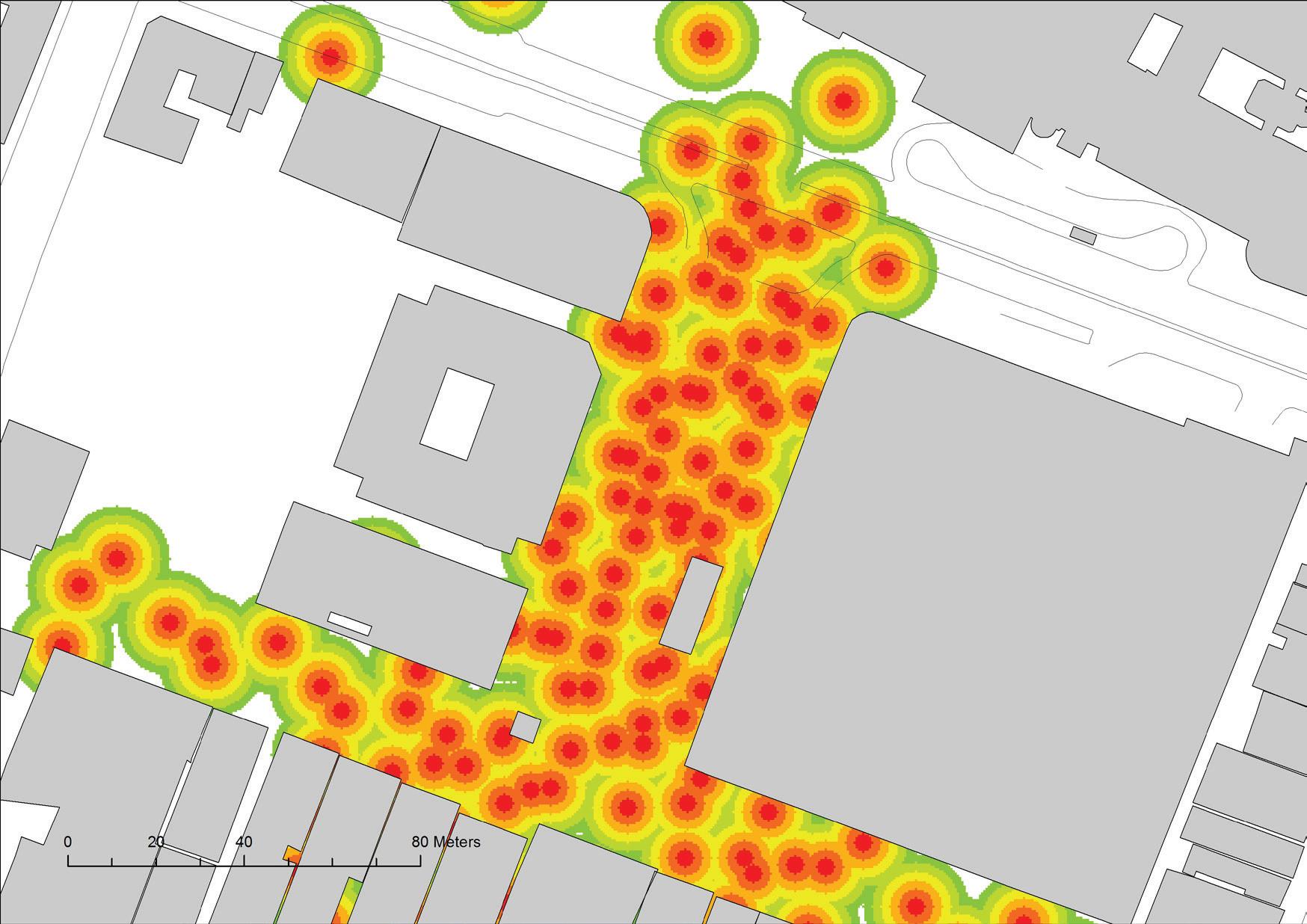
Wi-Fi pedestrian monitoring (simulated example for illustrative purposes only)
19
Case study: Shopping centre (unspecified)
Given that shopping centres have been using Wi-Fi monitoring for over 5 years the monitoring system has a number of metrics which have become conventions within the industry.
20
Project proponents
Aislelabs
Background
Given that shopping centres have been using Wi-Fi monitoring for over 5 years (Lowe, 2016) the monitoring system has a number of metrics which have become conventions within the industry. These tend to pick up a number of key aspects of people’s movements which are crucial to the way a shopping centre is managed.
Type of data collected
In a basic Wi-Fi monitoring exercise focussed on a shopping centre AisleLabs tends to collect the following types of passively and actively generated monitoring data using sensors arranged grid in the shopping centre ceiling:
• Number of visitors. This corresponds to the number of visitors who entered the location during a selected time period. The overall number includes those visitors who entered more than one time during the selected period as well (counted as multiple visits) (AislelabsFlow, 2016).
• Number of people passing by. This corresponds to people detected by the Wi-Fi sensors at the property who do not actually enter the property. This could be drivers on a nearby road or pedestrians on an adjacent sidewalk (AislelabsFlow, 2016).
• Time Spent. This corresponds to the average dwell time of visitors to the property for the selected time period (AislelabsFlow, 2016).
• New and Engaged Visitors. This corresponds to the number of new visitors and engaged visitors (people who spend a selected time period for a particular location) as a percentage of total visitors (AislelabsFlow, 2016).
• Visitor Engagement: This corresponds to the average engagement depicted for 3 time periods, Past hour, Today and Past week (AislelabsFlow, 2016).
Application of data
The data generated from such monitoring has a number of applications:
• In many cases such data is used by shopping centre operators to influence the rental value on certain retail tenancies (Adams, 2016). In short such operators are using this locational data to ‘negotiate rent with their tenants because they know how many people are going past their window…’ (Lowe, 2016).
• It can also inform design and programming interventions which can be directed towards improving the access and or attraction of areas which have a low number of visitors (Adams, 2016).
Degree to which Wi-Fi monitoring replaces conventional PLS
Given the scale and enclosed nature of most shopping centres, the high number of and given the applications of the data is focussed on commercial concerns rather than a nuanced fine grain PLS arguably Wi-Fi monitoring largely supersedes conventional PLS methods in this case.
21
Case study: Massachusetts Institute of Technology –iSPOTS, Boston
In the year 2000, MIT decided to undertake a vast operation of building a campus-wide Wi-Fi network...
22
Project proponents
Massachusetts Institute of Technology (MIT) Information Systems and Technology (IS&T)
Background
In 2000 MIT decided to undertake a vast operation of building a campus-wide Wi-Fi network. By 2005 this campus has over 3,000 active wireless access points providing full coverage of Wi-Fi in all academic and residential buildingsreferred to as iSPOTS (Sevtsuk, Huang, Calabrese, & Ratti, 2009, p. 328).
Type of data collected
The spatial analysis of Wi-Fi on campus required data from two sources:
• The first, obtained from the MIT Department of Facilities, was geospatial data of all buildings, rooms, and their respective uses as of 2005 (Sevtsuk et al., 2009, p. 330).
• The second was from MIT IS&T, which generates two constant streams of data, firstly the number of users per access point, and secondly the bytes transferred per access point (Sevtsuk et al., 2009, p. 330).
Application of data
The data generated from such monitoring has a number of applications:
• It can be used for site selection for new program. For instance when the MIT Campus Planning Committee engages in negotiations with a new evening snack cafeteria to open on campus (for instance), they can use the iSPOTS archive to aid their decision in
site selection, and even the opening hours of the facility (Sevtsuk et al., 2009, p. 334).
• It can inform space planners about the efficiency of space usage. This is done by charting the location patterns of Wi-Fi enabled devices against the original assigned use of space; for instance lecture hall, cafeteria, or seminar room (Sevtsuk et al., 2009, p. 328).
• In an emergency security officers can check the current status of Wi-Fi usage in a particular building and make an informed guess about how many people might be inside the building (Sevtsuk et al., 2009, p. 335).
• It can be employed as an information tool for MIT students on a daily basis. For example, an architecture student who is working at home might be wondering if it would be better to work in their studio at school, because other friends might be working there too. In this case they could go on-line to the iSPOTS digital map and check the given studio space and see how many students are currently using Wi-Fi network (Sevtsuk et al., 2009, p. 335).
Degree to which Wi-Fi monitoring replaces conventional PLS
Given the macro scale of the MIT campus, the high smart phone penetration in MIT’s demographic, and given the applications of the data is quite broad, arguably Wi-Fi monitoring largely replaces conventional public life in this case. Indeed to generate such data through a conventional public life analysis would be prohibitively expensive and time consuming.
23
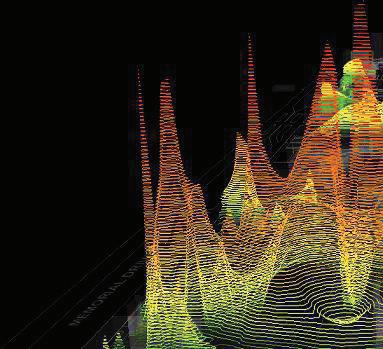
MIT Wi-Fi network visualisation
Image courtesy of http://senseable.mit. edu/ispots/images/JPGtop.JPG
24
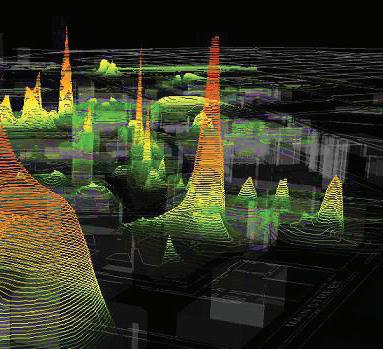
25
Case study: Queen Victoria Market, Melbourne
The Wi-Fi monitoring data was to be used to inform the renewal process and to give a picture of overall visitation numbers for particular event
26
Project proponents
City of Melbourne
Background
The Queen Victoria Market is a 7 hectare historic open air market in Melbourne. The market is in the process of being renewed to create a ‘world class’ market precinct with better facilities and public open spaces.
Type of Data collected
An initial Wi-Fi monitoring exercise was intended to provide information about how people were behaving – to a fairly fine level of detail – in the various spaces of Queen Victoria Market (Whitworth, 2016). Using a company (unnamed) who were geared towards shopping centre Wi-Fi monitoring the data generated was typical of such environments (Whitworth, 2016) (refer to AilseLabs case study). However due to the sites sprawling sheds (which can block Wi-Fi signals) and unenclosed spaces the detail of Wi-Fi monitoring data was lacking in some areas. It was also found that it was the number of sensors required to produce an ‘ant trails’ showing people’s movements required a prohibitively expensive number of sensors (Whitworth, 2016)
Application of data
The Wi-Fi monitoring data was to be used to inform the renewal process and to give a picture of overall visitation numbers for particular events (e.g . night market events) (Whitworth, 2016).
Degree to which Wi-Fi monitoring replaces conventional PLS
The operators of the Queen Victoria
Market found that Wi-Fi monitoring data could only be used in combination with other people counting systems. They argue that this is because when you are managing a public space (as opposed to shopping centre) there is a different level of accountability – in short the Wi-Fi data is not worth anything if it is not able to be validated with other methods (Whitworth, 2016). In this respect it is important to make sure that Wi-Fi monitoring companies allow access to the Wi-Fi monitoring data not just representations of the data. Otherwise it is difficult to know what assumptions are being made, for instance about the presumed smart phone penetration rates (Whitworth, 2016).
The experience at Queen Victoria Market also highlighted the inadequacies of Wi-Fi monitoring to understand people’s movements and activities at the micro scale in a particular public space (Whitworth, 2016). That said they found that Wi-Fi monitoring was able to give dwell times, something which conventional people counting systems are unable to provide (Whitworth, 2016).
Due to the mixed results described Wi-Fi monitoring at Queen Victoria Markets could only be considered as augmenting conventional PLS.
27

28

https://www.flickr.com/photos/ cadland/16198554708/
29
Victoria Market
Queen
Case study: Mandurah Crab Fest, Perth
During the annual ‘Mandurah Crab Fest’ there was a perception by local business owners that the festival wasn’t resulting in an increased number of people visiting their businesses...
30
Project proponents
Trendwise/ City of Mandurah
Background
During the annual ‘Mandurah Crab Fest’ there was a perception by local business owners that the festival wasn’t resulting in increased visitation of their premises. This was attributed to the fact that the festival was held on the Mandurah foreshore and as such was perceived as having its ‘back to the other parts of town’ (Mc Farlane, 2016).
Type of data collected
In response the City of Mandurah, through TrendwiseTM sensors and other Wi-Fi access points, passively and actively tracked mobile device users as to where they went during the festival weekend (Mc Farlane, 2016).
Application of data
This Wi-Fi monitoring exercise was driven by the question of whether the ~100,000 people who visit Crab Fest actually tend to go into the existing shops and businesses. In essence the exercise found out that they generally didn’t. As a result the City of Mandurah:
• Reconfigured the festival to use Mandurah’s main mall, and to integrate the Crab Fest within the city centre
• Relocated some Crab Fest activities out to Mandurah’s marina, and at the same time the expanded it to incorporate the commercial providers (Mc Farlane, 2016).
• Moreover the City of Mandurah were able to prove – through monitoring of the subsequent Crab Fest event –
that visitation of shops had increased markedly.
This study highlights the importance of utilising monitoring with a key research question in mind (Mc Farlane, 2016; Schaick, 2008, p. 193).
Degree to which Wi-Fi monitoring replaces conventional PLS
Given the scale of the monitoring exercise at the Mandurah Crab Fest arguably this would have been very difficult and expensive to replicate using traditional methods for measuring public life. At the macro scale of this study it can be argued that Wi-Fi monitoring effectively replaces a conventional PLS.
31
Case study: Elizabeth Quay, Perth
While only 30% of Wi-Fi users complete the survey, given Elizabeth Quay’s high visitation rates, this has resulted in over 40,000 completed surveys...
32
Project proponents
Metropolitan Redevelopment Authority, Culture Counts
Background
Elizabeth Quay is Perth’s recently opened urban water front, and arguably is the most significant, yet contested, urban project in Perth. Given its importance this Culture Counts study is focussing on measuring the experiences of people visiting Elizabeth Quay in personal, intellectual and emotional terms and correlating those with real physical data (Chappell, 2016).
Type of Data collected
Evaluative data is being collected via opt in questions for free Wi-Fi access. While only 30% of Wi-Fi users complete the survey, given Elizabeth Quay’s high visitation rates, this has resulted in over 40,000 completed surveys (Chappell, 2016).
Application of data
The evaluative data being measured on the Elizabeth Quay project relates to visitors’ perceptions of the place. While the survey questions can be varied the core dimensions of the survey relate to:
• Comfort,
• Accessibility (the ease with which you can get access to a place)
• Legibility
• Mobility (the ease with which you can move around within a place) (Chappell, 2016).
Beyond these metrics which were developed in conjunction with the MRA,
AIA and the OGA additional criteria can be included such as atmosphere, place, attractive and unattractive features, building heights, authenticity, community, culture, cycling, destinations (Chappell, 2016).
While this project is in its early stages the high level data generated could potentially be applied to:
• Making evidence based decisions regarding the project’s management and design modification (E.g. more shade, more seats) (Stefan Christiaan Van der Spek, Van Langelaar, & Kickert, 2012, p. 215).
• To understand community perceptions and preferences
• Conduct real time place management during events (E.g. knowing where more security or food trucks may be required)
Degree to which Wi-Fi monitoring replaces conventional PLS
Given the sheer numbers of people visiting Elizabeth Quay it would be unfeasible to conduct a PLS on the scale of the Culture Counts analysis. This said given that the Culture Counts process relives on surveying 30% of all free Wi-Fi users – and that this group is only about 5% of the total visitors there can be considered to be some potential bias in the sample.
33


Elizabeth Quay
Image courtesy of the MRA
Case study: Delft City Centre, Netherlands
The data generated by this project allowed for a prioritisation of city centre investment strategies...
36
Project proponents
Delft University of Technology
Background
This study focussed on pedestrian movements in the city centre of Delft, a city of about 100 000 inhabitants with a sizable historic core that serves as the retail, leisure, and cultural heart of the city and the region. (Stefan Christiaan Van der Spek et al., 2012, p. 207).
Type of Data collected
The movements of tree groups of studied using GPS tracking devices:
• Visitors;
• City centre inhabitants;
• Residents of adjacent neighbourhoods.
GPS tracking devices were chosen over smart phone based Wi-Fi or Bluetooth monitoring because it was considered the sample would then be biased toward smart phone owners, ‘most likely a younger and more tech-savvy demographic’ (Stefan Christiaan Van der Spek et al., 2012, p. 208) While this project did not utilize Wi-Fi monitoring data it is instructive in terms of how monitoring data has been applied.
Application of data
The data generated by this project allowed for a prioritisation of city centre investment strategies:
• Intensely used yet ‘poor’ quality public open spaces prioritised for investment;
• High-quality public space that is poorly used prioritised for upgraded
connections or at least signposted (Stefan Christiaan Van der Spek et al., 2012, p. 214).
Degree to which Wi-Fi monitoring replaces conventional PLS
The proponents of the study concluded that GPS tracking technology was highly effective but that it was ideally combined with more conventional methods such as mind mapping or footfall counts as they regarded each approach has its advantages and disadvantages (Stefan Christiaan Van der Spek et al., 2012, p. 215).
37
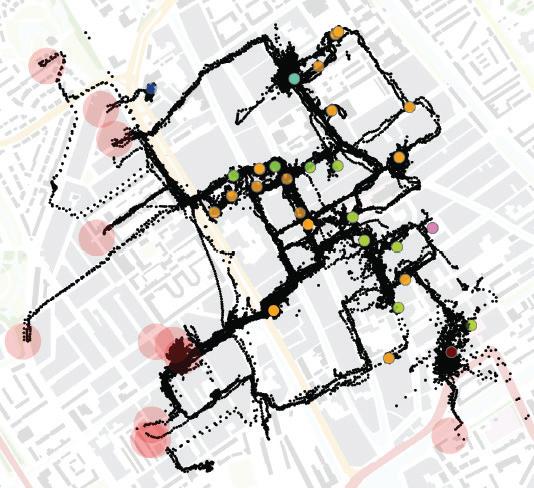
Delft city centre GPS tracking diagram
Image courtesy of http://docplayer. net/16496878-Visualizing-pedestrianflows-using-gps-tracking-to-improveinner-city-quality-no-200.html
The potential of Wi-Fi monitoring and opt in surveys to augment
a conventional PLS
The immediacy of the information garnered through Wi-Fi monitoring potentially allows for the real-time management of the public realm...
40
The potential
of Wi-Fi
monitoring to augment a conventional PLS
The following section, and accompanying table, considers the degree to which Wi-Fi monitoring of Wi-Fi users in public spaces can augment a conventional PLS.
Counting
Counting as Jan Gehl defines it can be broken down into counting the number of people who are moving, how many are stationary, and what activities the stationary people are engaged in.
Counting how many people are moving
Wi-Fi monitoring is highly effective in counting moving people with a Wi-Fi enabled device however there are technical limitations in terms of how the data is collected – in short it is only collected from people with Wi-Fi enabled devices and therefore relying on this data alone potentially introduces a significant compositional bias (Lowe, 2016; Schaick, 2008, p. 189). For instance, the demographic composition of people with Wi-Fi devices can tend towards being young and well educated (Hampton et al., 2010, p. 709) and as such relying on Wi-Fi monitoring data alone to calculate how many people are moving could mean that significant proportions of the total numbers of people moving could be missing. While there are quite well established statistical models for calculating the bias (Lowe, 2016), and traditional surveys can be undertaken to test these, inevitably there is a slippage between the model and ‘reality.’ Indeed in some cases the number of people who are ‘invisible’ in
Wi-Fi monitoring can be roughly commensurate with those passively observed through Wi-Fi monitoring (Ang, 2016). Moreover, the bias becomes particularly pronounced if only active, not passive, monitoring is being carried out (Lowe, 2016). Indeed, in some urban precincts, only about five percent of people opt-in to active Wi-Fi connections meaning that a substantial proportion of the total number of people moving is not represented (Ang, 2016). As a result of these problems the operators of the Queen Victoria Market in Melbourne Australia found that Wi-Fi monitoring data could only be used in combination with other people counting systems. As they argue Wi-Fi monitoring data is ‘not worth anything if it is not able to be validated with other methods’ (Whitworth, 2016).
Notwithstanding its bias Wi-Fi monitoring data generated by the movement of people with Wi-Fi enabled devices, particularly at the precinct scale has significant potential as it allows a far greater sample size and spatial distribution to be analysed (Sevtsuk et al., 2009, p. 334) over a much longer time frame, than what is generally feasible in a PLS which would require a substantial number of observers recording people movements to cover the same geographic area and time.
Moreover the immediacy of the data garnered through monitoring of the movement of people with Wi-Fi enabled devices potentially allows for the real-time management of the public realm (Schaick, 2008, p. 191) something which a conventional PLS would struggle to replicate. As Jason
41
MacFarlane explains Wi-Fi monitoring of an event or festival in an urban precinct can be done on ‘minute by minute day by day… as such you can program on a minute by minute basis and be shifting assets around accordingly. And you can certainly be experimenting with shade, parking, all the things that you can move around’ (Mc Farlane, 2016). Moreover the process of implementing urban design and managing urban events may become much more iterative as designers/ managers engage with real time data and feedback from users.
Counting how many people are engaged in stationary activities
Wi-Fi monitoring is highly effective for counting people with Wi-Fi devices engaged in stationary activities however – as with the above – those without such a device are invisible. On example is the Massachusetts Institute of Technology (MIT) where Wi-Fi monitoring data generated at a campus scale inform space planners about the efficiency of space usage. This is done by charting the location patterns of typically stationary people with a Wi-Fi enabled device against the original assigned use of space; for instance lecture hall, cafeteria, or seminar room (Sevtsuk et al., 2009, p. 328). The sample size, spatial area and temporal period of this study would be extremely difficult to replicate in a conventional PLS.
Such abilities aside Wi-Fi monitoring of people with a Wi-Fi enabled device engaged in a stationary activity forces researchers to question suppositions on human behaviour, as the provision of a Wi-Fi network changes people’s activity
behaviour (Schaick, 2008, p. 185) – in short one of the main stationary activities that people with a Wi-Fi enabled device may be engaged in will be using the public Wi-Fi itself. Indeed the provision of a Wi-Fi network in an urban precinct can reduce the sociability of public spaces; in one study the large majority of Wi-Fi users in public space had a low density of co-located acquaintanceships (Hampton et al., 2010, p. 710). The provision of Wi-Fi networks for the purpose of monitoring people with a Wi-Fi enabled device contradicts Jan Gehl’s idea that the observer must be as neutral as the proverbial ‘fly on the wall,’ an invisible non-participant who takes in the big picture without taking part in the event (Gehl, 2013, p. 5).
Counting what stationary activities people are engaged in (cultural or commercial activities, playing, lying down, seated, seated in cafe seating or standing)
Passive or active Wi-Fi monitoring is often useful for telling the researcher the ‘what’ but not the ‘why’ (Mc Farlane, 2016) and in that respect Wi-Fi monitoring departs from the more traditional in-depth studies of PLS (Sevtsuk et al., 2009, p. 334). In short Wi-Fi monitoring of people with Wi-Fi enabled devices can tell those collecting the data that those people are stationary but not why they are stationary i.e. what stationary activity they are undertaking – This could be garnered from opt in questionnaires for Wi-Fi access however again a reliance on this distorts the sample, as typically only a low percentage of people actively connect
to a Wi-Fi network. In contrast when observers are manually conducting the counting of people undertaking stationary activities, they can add information from the site, such as the activity being undertaken or the demographic profile (Gehl, 2013, p. 6).
Mapping stays
Passive and active Wi-Fi monitoring –notwithstanding its inherent bias –is able to indicate approximately where ‘stays’ are concentrated and for how long. This ability has been pioneered in shopping centres where stays – referred to as ‘dwell times’ (AislelabsFlow, 2016) –serves as a powerful analytical tool for shopping centre operators.
Nonetheless the ability of Wi-Fi monitoring to accurately measure the spatial location of stays is questionable. Indeed in some public realm examples the locational data of a person with a Wi-Fi enabled device can be ‘out’ by as much as 10 to 15 metres depending on the frequency of sensors (Ang, 2016). This means while using Wi-Fi monitoring to determine the location of stays at the precinct scale can be instructive, at the site scale it is likely to so inaccurate as to be of questionable use. To combat this inaccuracy at the finer scale, shopping centres tend to use a large number of Wi-Fi monitoring sensors, typically on a three metre grid hidden in ceilings. This results in greater accuracy and can generally accurately locate Wi-Fi users within one metre (Ang, 2016), however deploying this number of sensors this unlikely to be feasible in the public domain.
Spatial accuracy issues aside Wi-Fi
monitoring does allow the accurate mapping of the stay times of people with a Wi-Fi enabled device, something which is difficult to do with a conventional PLS in which the time period of the survey may be exceeded by a person’s dwell time (Ang, 2016). Furthermore the mapping of stays can occur over an extended time period –days, weeks, months or years, and can record whether people have been in a location previously or have made multiple visits (AislelabsFlow, 2016). In this respect Wi-Fi monitoring of people with Wi-Fi enabled devices is potentially a powerful diagnostic tool of the effect of urban interventions through the analysis of both visitation numbers but also how whether the interventions have encouraged people to stay for longer periods (Adams, 2016). In this new regime designers and managers will likely become much more accountable for the outcomes of their work in terms of total visitation and stay times (Chappell, 2016)
Tracing, tracking movement
The spatial inaccuracy of Wi-Fi monitoring of stays also inhibits the use of Wi-Fi monitoring data at the site scale for tracing and tracking movements of people with Wi-Fi enabled devices (Nielsen, 2014, p. 2). This is confirmed by the experience of the operators of Queen Victoria Market in Melbourne who explained that the number of sensors required to produce an ‘ant trails’ showing people’s movements required a prohibitively expensive number of sensors (Whitworth, 2016). Again this issue is particularly scale dependent; while tracking movements
43
through Wi-Fi monitoring is problematic at the site scale at the precinct scale it is potentially very useful as spatial inaccuracies have less significance.
Notwithstanding its bias Wi-Fi monitoring data generated by the movement of people with Wi-Fi enabled devices, particularly at the precinct scale has significant potential as it allows a far greater sample size and spatial distribution to be analysed (Sevtsuk et al., 2009, p. 334), than what is generally feasible in a PLS which would require a substantial number of observers recording people movements to cover the same geographic area.
Photography
Conventional PLS often employs photography to illustrate situations and interactions, or lack thereof, between public space and public life (Gehl, 2013, p. 31). Wi-Fi monitoring data itself tends to represented in heat maps showing concentrations of Wi-Fi enabled devices superimposed over a base plan or aerial photo it has no mechanism for recording the subtleties of public life that a human observer with a camera can achieve.
While Wi-Fi monitoring could be used in conjunction with an automated camera system – perhaps triggered by particular scenarios – such a system is unlikely to be able to capture the subtleties which can be discerned by the human eye and recorded through photography.
Keeping a diary
Finally through ‘keeping a diary’ in a conventional PLS observers can register details and nuances about the interactions between public life and public space, noting observations (Gehl,
2013, p. 24). In this respect passive or active Wi-Fi monitoring of people with a Wi-Fi enabled device has little capacity for recording the nuances of interactions between public life and spaces other than those that manifest themselves in data. In short Wi-Fi monitoring provides quantitative data but not an understanding of the qualitative reasons for why certain data is being produced; for example people are congregating in one area of a space because it is sunny, sheltered from the wind, has a ‘nice’ view, provides a good position to people watch or enables people to sit with their back to a wall of pillar (Whyte, 1980). This should not be considered a fatal flaw though – indeed the quantitative tools of a conventional PLS also need to be augmented by qualitative interpretations of otherwise sometimes abstract data. It does however reinforce the need to be wary of when technology providers attempt to ‘seduce’ urban designers and managers with purely technical solutions (Whitworth, 2016).
45
The potential of Wi-Fi monitoring and opt in surveys to augment traditional PLS
PLS general category of analysis
Counting
Description
Typical PLS method of analysis
Counting how many people are moving Human observation
Mapping stays
Counting how many people are engaged in stationary activities Human observation
Counting what stationary activities people are engaged in Human observation
Mapping what happens in a space to indicate stays- where people are standing and sitting. Human observation/ mapping
Site scale potential Precinct scale potential








Notes
This table sets out the main categories of PLS and the degree to which Wi-Fi monitoring data can augment such methods
+ Passive and active Wi-Fi monitoring can expand sample sizes, spatial area and temporal scope of counting
- Counting only people with Wi-Fi devices distorts sample
+ Wi-Fi monitoring is highly effective for counting people with Wi-Fi devices engaged in stationary activities and expand sample sizes, spatial area and temporal scope of counting
- Counting only people with Wi-Fi devices distorts sample
- Passive and active Wi-Fi monitoring cant indicate what activities people with Wi-Fi devices are undertaking
+ This information could be garnered from opt in surveys however reliance on this data alone introduces sample bias
- Inaccuracies of Wi-Fi monitoring (often +/- 10m) limits its use in mapping stays at the site scale in particular
+ Wi-Fi monitoring however does allow the accurate mapping of the dwell times of Wi-Fi users over longer time periods
47
PLS general category of analysis
Tracing/ tracking movement
Description
Recording pedestrian movements
Typical PLS method of analysis
Human observation/ mapping/ timelapse photography
Photography Photographs are frequently used in the field of public life studies to illustrate situations. Photographs and film can describe situations showing the interaction or lack thereof between urban form and life
Keep a diary
Photography/ timelapse
Human observation
Site scale potential Precinct scale potential


Notes




- Inaccuracies of Wi-Fi monitoring (often +/- 10m) limits its use in tracing/ tracking movement at the site scale in particular
+ At the precinct scale where such inaccuracies have less significance passive or active Wi-Fi monitoring has signficant potential for tracking the movement of large numbers of people
- Conventional PLS often employs photographs to illustrate situations. While Wi-Fi networks could be employed in conjunction with an automated camera system – however such a system is unlikely to be able to capture the subtleties which can be discerned and recorded with the human eye.
- Wi-Fi monitoring has no capacity for recording the qualitative nuances of interactions between public life and spaces other than those that manifest themselves in data
49
Conclusion
In conclusion a combination of the Wi-Fi monitoring technology with more conventional PLS methods can fill in most methodological gaps as each approach has its advantages and disadvantages...
50
A combination of methods
As the prior sections indicate a combination of the Wi-Fi monitoring a with more traditional, particularly qualitative, PLS methods can fill in most methodological gaps as each approach has its advantages and disadvantages (Van der Spek et al., 2012, p. 215). As Gehl himself explains ‘a single tool is rarely sufficient. It is usually necessary to combine various types of investigation’ (Gehl, 2013, p. 22). The decision of whether to prioritise a particular method will depend on the scale of the study (site to precinct), the intended timeframe of the study, the people power available to undertake a PLS, and whether money is available for investments in the required equipment.
Nonetheless, as a general summation, broader precinct scale public life studies, with longer durations are much more suited to Wi-Fi monitoring methods while finer scale, shorter term, and more nuanced studies are more suited to conventional PLS methods based on human observation. In either case both require qualitative assessments, through photography and human observation, to interpret why particular patterns in the data are being produced.
Future research
Future research in this area could be directed towards formalising a method for assessing public life in urban precincts which relies on a combination of Wi-Fi monitoring, human observation, and qualitative assessment. The resultant method should be, as much as possible, able to be replicated in a controlled way so that the data
generated is able to be verified and trusted. This necessarily brief report has been intended to provide the background to forming such an updated method. Without such a method being formalised many mistakes can be made by planners and designers who are unfamiliar with the technology in particular.
Conclusion
By way of conclusion, it is important to keep in mind that, however augmentable by Wi-Fi technology PLSs are, we are ‘still dealing with real places and their qualities, and that is central to it all’ (Aurigi, 2016, p. 20). As Alessandro Aurigi explains:
The overly nonchalant jettisoning of what we know about urban design in the name of an unexplored ‘digital’ world and its alleged new rules is not a good starting point towards shaping the digitally-augmented city (2016, p. 20).
This report has been directed towards better understanding the degree to which Aurigi’s ‘digital world’ can really augment the timeless process of human observing of other humans ‘on the ground’…
51
References
52
Adams, S. (2016). Interview with Scott Adams, Director Taylor Cullity Lethlean In J. Bolleter (Ed.). Not published.
AislelabsFlow. (2016). Glossary of key terms from the dashboard (pp. 1-20). Toronto, New York, Dubai: AislelabsFlow.
Ang, K. (2016). Interview with Kamie Ang, Managing Director Technical Services Group. In J. Bolleter (Ed.). Unpublished.
Aurigi, A. (2016). No need to fix: Strategic inclusivity in developing and managing the smart city. In G. A. Caldwell, C. Smith & E. Clift (Eds.), Digital Futures and the City of Today: New Technologies and Physical Spaces (pp. 9-28). Bristol, Chicago: intellect.
Chappell, M. (2016). Interview with Michael Chappell, Managing Director Pracsys. In J. Bolleter (Ed.). Not published.
CultureCounts. CultureCounts.
Retrieved 20.09, 2016, from https:// culturecounts.cc/
Gehl, J. (2013). How To Study Public Life. Washington: Washington : Island Press/Center for Resource Economics.
Hampton, K. N., Livio, O., & Sessions Goulet, L. (2010). The social life of wireless urban spaces: Internet use, social networks, and the public realm. Journal of communication, 60(4), 701-722.
Kalogianni, E., Sileryte, R., Lam, M., Zhou, K., Van der Ham, M., Van der Spek, S. C., & Verbree, E. (2015). Passive WiFi monitoring of the rhythm of the campus. Paper presented at the
Proceedings of The 18th AGILE International Conference on Geographic Information Science; Geographics Information Science as an Enabler of Smarter Cities and Communities, Lisboa (Portugal), June 9-14, 2015; Authors version.
Lambert, A., McQuire, S., & Papastergiadis, N. (2013). Free Wi-Fi and public space: the state of Australian public initiatives.
Lowe, M. (2016). Interview with Matt Lowe, ARUP. In J. Bolleter (Ed.). Not published.
Mc Farlane, J. (2016). Interview with Jason Mc Farlane, Managing Director of Far lane. In J. Bolleter (Ed.). Not published.
Nielsen, S. Z. (2014). Movement Pattern Analysis in ‘Smart Cities’. GIScience 2014.
Pearce, B. (2016). Interview with Brent Pearce, Senior Business development Manager Trendwise. In J. Bolleter (Ed.). Not published.
Ratti, C., Frenchman, D., Pulselli, R. M., & Williams, S. (2006). Mobile landscapes: using location data from cell phones for urban analysis. Environment and Planning B: Planning and Design, 33(5), 727-748.
Schaick, J. (2008). Tracking ResearchAn Agenda for Urban Design and Planning. In J. Schaick & S. C. Spek (Eds.), Urbanism on track: Application of tracking technologies in urbanism (Vol. 1, pp. 183-198): IOS Press.
Sevtsuk, A., Huang, S., Calabrese, F., & Ratti, C. (2009). Mapping the MIT
53
campus in real time using WiFi. Handbook of Research on Urban Informatics: The Practice and Promise of the Real-Time City.
Spek, S. C. (2008). Tracking Technologies- An Overview. In J. Schaick & S. C. Spek (Eds.), Urbanism on track: Application of tracking technologies in urbanism (Vol. 1, pp. 25-34): IOS Press.
Swaffield, S., & Deming, E. (2011). Research Strategies in Landscape Architecture: Mapping the Terrain. Journal of Landscape Architecture, Spring 2011, 34- 45.
Van der Spek, S. C., Van Langelaar, C. M., & Kickert, C. C. (2012). Evidencebased design: satellite positioning studies of city centre user groups. Proceedings of the ICE-Urban Design and Planning, 166 (4), 2013.
Van Schaick, J., & Van der Spek, S. (2007). Application of tracking technologies in spatial planning processes: an exploration of possibilities.
Whitworth, F. (2016). Interview with Fiona Whitworth, Director of Strategy Queen Victoria Market. In J. Bolleter (Ed.). Not published.
Whyte, W. (1980). The Social Life of Small Urban Spaces. Baltimore: The Conservation Foundation.
55
Contributors
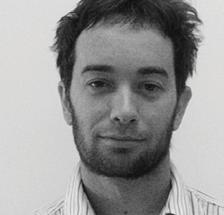
Julian Bolleter
Julian is an Assistant Professor at the Australian Urban Design Research Centre (AUDRC) at the University of Western Australia. His role at the AUDRC includes teaching a master’s program in urban design and conducting urban design related research and design projects.
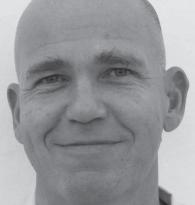
Dr Joerg Baumeister
Joerg is Director of the Australian Urban Design Research Centre (AUDRC) and has been researching, practising, educating and exploring Urban Design and Architecture for more than 20 years in Australia, Europe, Africa, and on the Arabian Peninsula.
56
57
















